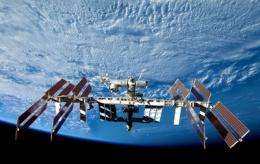International Space Station. Credits: ESA
In a study published today in The Journal of Physiology, researchers found that in space, the shift of blood and fluid from the lower to the upper body caused by weightlessness is much higher and the blood pressure much lower than previously thought.
Researchers measured the volume of blood ejected by the heart into the blood vessels and monitored the blood pressure in eight astronauts aged between 45-53 years during a 24 h period with portable equipment. Recordings were taken before, during and after 3-6 months of spaceflight. A blood sample was also collected to analyse the nervous regulation of the cardiovascular system.
The team of researchers found that the shift of blood and fluid from the lower to the upper body caused by weightlessness was much higher than previously thought. The blood volume burden to the heart was also more than expected despite the heart rate remaining the same. At the same time, blood pressure was considerably reduced by 10 mmHg, which corresponds to the effect of normal blood pressure medication against high blood pressure.
Dr Peter Norsk, lead author of the study says: "The discovery is important because during long duration missions, the blood volume burden to the heart could constitute a health problem during future long duration missions. We know that some astronauts experience vision problems some months into spaceflight and this may in fact be caused by the augmented fluid and blood volume shift to the upper body.
Although the blood volume burden to the heart is higher than expected, blood pressure is lower because the blood vessels are more relaxed (dilated). This is actually good for the body and the blood vessels.Thus, there are one or more spaceflight factors leading to these changes, which haven't been identified yet. In the future, the spaceflight factors that induce the fluid shifts and relaxation (dilatation) of the blood vessels should be identified."
More information: Norsk P, Asmar A, Damgaard M & Christensen NJ (2015) Fluid Shifts, Vasodilatation and Ambulatory Blood Pressure Reduction during Long Duration Spaceflight. J Physiol DOI: 10.1113/jphysiol.2014.284869
Journal information: Journal of Physiology
Provided by Wiley





















